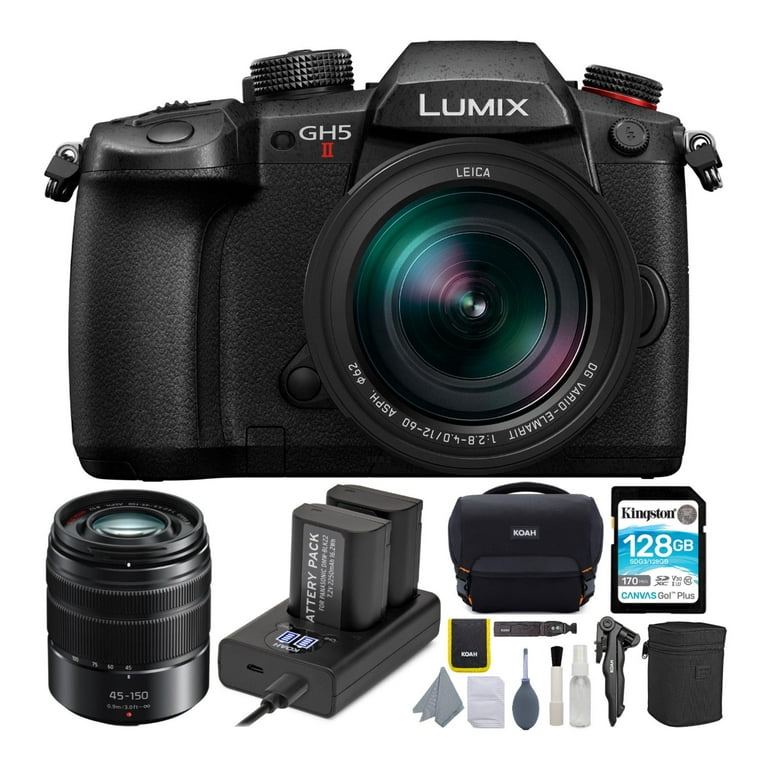Key Takeaways
-
The Panasonic Lumix GH5 is a versatile camera that excels in wildlife videography, thanks to its 4K video capabilities, image stabilization, and high frame rates.
-
Understanding the camera’s settings and features is crucial for capturing sharp, stable, and high-quality footage in the dynamic environment of wildlife.
-
Preparation is key; knowing the best times for wildlife activity and having the right gear can make or break a shoot.
-
Composition, lighting, and patience are essential skills for creating compelling wildlife footage that tells a story.
-
Post-production is where the footage comes to life, with editing and sound design adding depth and emotion to the visual narrative.

“Panasonic Lumix GH5 II Mirrorless …” from www.walmart.com and used with no modifications.
Unlocking the Power of Panasonic Lumix GH5 for Wildlife
When you hold the Panasonic Lumix GH5 in your hands, you’re not just holding a camera; you’re holding a storyteller. This camera is more than a tool—it’s a companion for those who venture into the wild to capture the untamed beauty of nature. With its robust build and advanced features, it’s no wonder the GH5 has become a favorite among wildlife filmmakers. But to truly harness its power, you need to know more than just its specs; you need to know how to make it work for you.
Capturing Nature’s Finest: Essentials for Exceptional Footage
The dance of a butterfly, the sprint of a cheetah, the silent swoop of an owl—wildlife moments are fleeting. To capture them, your camera must become an extension of your eyes, your hands, and your creative vision. The GH5, with its 4K video capability, offers an immense canvas to paint these moments in vivid detail. But it’s not just about resolution; it’s about the clarity and fluidity of the motion, the colors that burst to life, and the textures that feel almost tangible.
For wildlife footage that truly stands out, you need to dive into the camera’s settings. Frame rate, focus, and exposure—these are the elements that can transform a simple video into a visual feast. And the GH5 gives you the control you need to fine-tune these settings, ensuring that whether you’re shooting in the golden glow of dawn or the deep shadows of dusk, your footage remains crisp and vibrant.
The GH5’s Edge: Technology Meeting Creativity
The GH5 isn’t just about capturing what you see; it’s about capturing what you feel. The camera’s technology is designed to meet your creativity every step of the way. Its in-body image stabilization counters the shake of your hands as you track a bird in flight. The weather-sealing protects your creative endeavors against the elements. And the customizable buttons allow you to access your favorite settings without losing sight of your subject.
Core Features & Settings for the GH5
Every feature of the GH5 is a building block for your wildlife story. Let’s break down the core features and settings that you’ll use to craft your narrative.
Embracing 4K: Why Resolution Matters
Why does 4K resolution matter in wildlife videography? It’s simple: detail. The more pixels you have, the more you can see the intricacies of a creature’s fur, the delicate veins of a leaf, the distant gaze of an animal. It brings the viewer into the world you’ve witnessed, making them feel as though they’re right there with you.
But 4K isn’t just about sharpness; it’s about flexibility in post-production. Want to crop a frame and still maintain high quality? 4K gives you that freedom. Want to stabilize your footage in editing software without losing resolution? Again, 4K is your friend. It’s a feature that both future-proofs your work and enhances your current projects.
Stabilization: Keeping Your Shots Steady in the Wild
Imagine you’re filming a leopard stalking its prey. Your heart races, your hands might tremble, but your footage? It has to be steady. That’s where the GH5’s in-body image stabilization (IBIS) comes into play. It compensates for camera movement, smoothing out the jitters that can occur when you’re shooting handheld.
The GH5’s Dual I.S. 2 system takes it a step further by combining in-body and lens stabilization. This synergy provides up to 5 stops of compensation, making it possible to shoot at slower shutter speeds and lower ISOs, which is critical in low light conditions often encountered in wildlife photography.
High Frame Rate Video: Slowing Down the Action
Wildlife moves at its own pace. To capture the swift strike of a snake or the fluttering wings of a hummingbird, you need the ability to slow things down. High frame rate (HFR) video is your key to unlocking this dimension of time.
The GH5 can shoot up to 180 frames per second in Full HD, allowing you to create smooth slow-motion footage that reveals every nuance of your subject’s movement. This feature isn’t just about dramatic effect; it’s about showing the world aspects of wildlife behavior that are often too fast for the naked eye to appreciate.
V-Log: Achieving Cinematic Color Grading
The true beauty of wildlife isn’t just in the movement; it’s in the colors. With V-Log, you can capture a wider dynamic range, giving you more detail in both the shadows and the highlights. This flat color profile is like a blank canvas for your creativity in post-production, allowing you to color grade your footage to achieve a look that’s as unique as your vision.
V-Log also ensures that you preserve all the visual information you need to bring your story to life. When you’re out in the field, you might not have control over the lighting, but with V-Log, you have control over your colors. And that can make all the difference.
Preparing for the Shoot
Before you step into the wild, preparation is your ally. The right preparation puts you at the right place at the right time, with the right gear. It’s about understanding the rhythm of the natural world and syncing your filmmaking process to it. You’re not just going to capture wildlife; you’re going to meet it in its own home. And that requires respect, patience, and a keen eye for detail.
Scouting and Timing: When to Capture Wildlife
The golden hours of dawn and dusk are not just beautiful; they’re also when many animals are most active. But each animal has its own schedule. Birds might be best filmed during their morning chorus, while nocturnal creatures come alive as the sun sets. Do your research, understand your subject’s behavior, and plan accordingly. And remember, the most magical moments in wildlife often come unannounced, so always be ready. For more insights, explore how to produce animal videos like a pro.
Packing Smart: Essential Gear for a Wildlife Shoot
On a wildlife shoot, every piece of gear must earn its place in your backpack. Besides your GH5 and a selection of lenses, consider the following:
-
Extra batteries and memory cards – you don’t want to run out of power or space at a crucial moment.
-
A sturdy tripod or monopod for stability, especially for those long-wait shots.
-
Weather protection for your gear, because nature doesn’t care about your shooting schedule.
-
Binoculars to spot distant wildlife without disturbing them.
-
A field guide to the area’s wildlife, so you know what you’re looking for and where to find it.
On Location: Hints for Capturing Compelling Footage
Once you’re in the field, it’s all about the dance between patience and readiness. Your senses must be tuned to the environment, always scanning for movement, listening for sounds, and being mindful of the story unfolding before you.
Composition: Framing Your Wildlife Subject
Good composition is what turns a clip into a scene. Use the rule of thirds to place your subject in a way that feels natural and gives context. Look for leading lines – a river, a branch – that guide the viewer’s eye to your subject. And don’t forget to consider the background; it should complement, not distract from, your wildlife star.
Lighting: Working with Natural Light Outdoors
Natural light is unpredictable, but it’s also your greatest asset. The soft, diffused light of an overcast day can reduce harsh shadows and bring out the colors of a bird’s plumage. The warm glow of sunrise or sunset can add drama to a landscape, making your subject stand out. Learn to work with what you have, and you’ll find that nature is the best lighting director you could ask for.
Patient Pursuit: The Art of Waiting for the Perfect Shot
Wildlife filmmaking is a waiting game. Sometimes, it’s the hours you spend motionless, camouflaged, and silent that lead to the most breathtaking footage. It’s not just about the physical wait, though. It’s about understanding animal behavior, predicting their next move, and being ready to capture it. That’s where the real magic happens.
Remember, while you wait, keep your camera ready. Settings should be dialed in, and your composition should be set. That way, when the moment arrives, you’re capturing it, not fumbling with dials.
Post-Production Workflow
In the world of wildlife filmmaking, the story is often found in the edit. It’s where the raw material of your footage is sculpted into a narrative. This is where you choose the shots that convey the emotion and story you want to tell. And with the GH5’s high-resolution footage, you have a rich palette to work with.
Start by organizing your clips, categorizing them by subject, behavior, or light quality. Then, begin the process of selecting the best takes, looking for the moments that best capture the essence of your subject.
Editing is not just about cutting; it’s about pacing, about building tension and release, about guiding the viewer through the story you’ve captured. The right cut can make a simple scene feel like a revelation, a glimpse into the soul of the wild.
And let’s not forget about sound. The rustle of leaves, the call of a bird, the crunch of snow underfoot – these are the sounds that immerse your viewer in the experience. They’re just as important as the visual, so give them the attention they deserve in your edit. For more on capturing the essence of the wild, check out our insights on nocturnal wildlife videography.
Editing for Emotion: Storytelling with Your Footage
When you sit down to edit, you’re not just piecing together clips; you’re crafting emotions. Look for the moments that made your heart race or took your breath away. Those are the moments that will resonate with your audience. Use music and sound design to enhance these emotions, to build a soundscape that complements your visuals.
Sound Design: Enhancing the Natural Environment
The chirps, growls, and whispers of the wild add a layer of depth to your footage that visuals alone can’t convey. When you’re editing, consider the role of ambient sounds. They can transport your audience to the heart of the jungle or the edge of a river. And when used thoughtfully, they can elevate your story from a mere recording to a sensory experience.
Most importantly, your post-production workflow should be a continuation of the story you started telling in the field. With the GH5’s footage as your canvas and your creativity as the brush, the stories you can tell are as boundless as the natural world you’re capturing.
Intimate Bird Behavior: A Close-up Chronicle
There’s a delicate art to capturing the nuanced behavior of birds in their natural habitat. It requires a blend of technical prowess and a deep understanding of avian activities. With the GH5, you can record in 4K to capture every feather rustle and beak peck in exquisite detail. High frame rates allow for smooth slow-motion that unveils the subtlest of movements, while the camera’s silent mode enables you to shoot up close without disturbing your feathered subjects.
Predator in Action: Documenting the Hunt
Witnessing a predator in pursuit of its prey is one of nature’s most thrilling spectacles. The GH5’s quick autofocus system ensures you keep the action sharp, while the ability to shoot at high frame rates captures every split-second decision and movement. These features, combined with a telephoto lens, bring the intensity and drama of the hunt right to your viewers, allowing them to feel the pulse-pounding action as if they were there.
FAQs About Capturing Wildlife with the GH5
When it comes to wildlife videography, certain questions frequently arise. Here, we’ll tackle some common queries about using the Panasonic Lumix GH5 in the field.
Can the GH5 handle low-light conditions for dawn or dusk wildlife footage?
Low-light performance is critical for wildlife videographers. The GH5 boasts a 20.3-megapixel sensor without a low-pass filter, enhancing its ability to capture sharp images in dim conditions. While not the highest performer in extreme low light compared to some full-frame cameras, it still holds its own at dawn and dusk with proper settings and lenses.
For low-light shooting, pair the GH5 with a fast lens – one with a wide aperture like f/2.8 or wider – to allow more light to reach the sensor. Boost the ISO judiciously, and utilize the camera’s in-body stabilization to keep your footage smooth without a tripod.
What are the best lenses to pair with the GH5 for wildlife photography?
Choosing the right lens is as important as the camera itself. For wildlife, you’ll often want a telephoto lens to capture subjects from a distance. The Lumix G Leica DG Vario-Elmar 100-400mm is a popular choice for its range and sharpness. For wider shots, the Lumix G X Vario 12-35mm f/2.8 offers versatility and excellent image quality.
How do I extend battery life when shooting in the field for long hours?
Maximizing battery life is crucial during long shooting sessions. Always carry spare batteries, and consider investing in a battery grip for the GH5. When not actively shooting, turn off the camera or use sleep mode. Lowering the monitor brightness and minimizing playback can also help conserve power.
Is the GH5 weather-resistant for challenging outdoor environments?
Yes, the GH5 is built to withstand the rigors of outdoor shooting. Its weather-sealed body resists dust, splashes, and freezing temperatures, making it a reliable choice for wildlife videography in various conditions. However, always ensure that your lenses and other accessories are equally weather-resistant.
What are some recommended settings for capturing fast-moving wildlife?
For fast-moving subjects, a high shutter speed is essential. Set the GH5 to shutter priority or manual mode and choose a speed of at least 1/500th of a second to freeze motion. Activate the continuous autofocus (AF-C) mode with custom settings tailored to your subject’s speed and erratic movement patterns. Combine this with a high frame rate video option for smooth slow-motion playback.
Remember, the Panasonic Lumix GH5 is more than just a camera; it’s a gateway to the untamed world of wildlife. With its robust features, it invites you to explore, observe, and ultimately, tell the stories hidden in the wilderness. So go ahead, craft your story!




